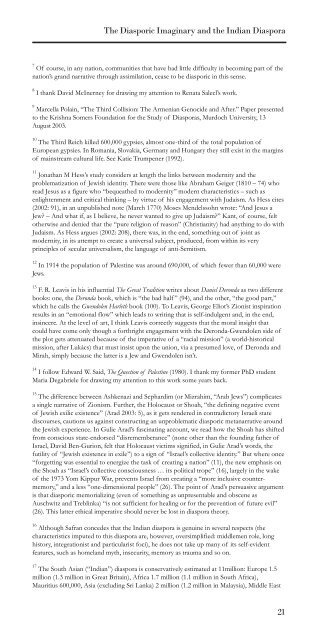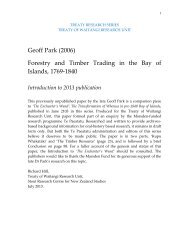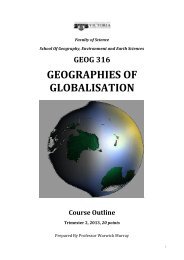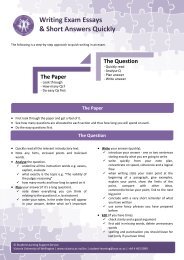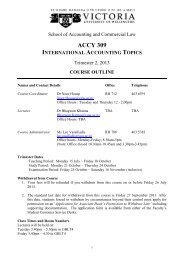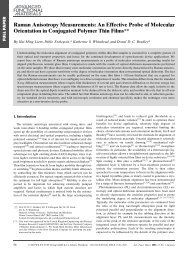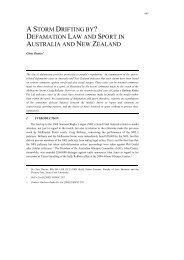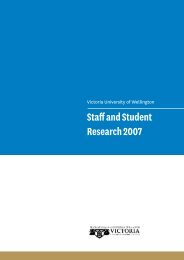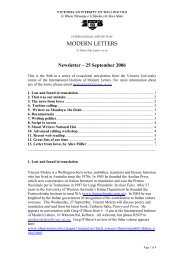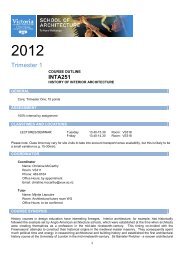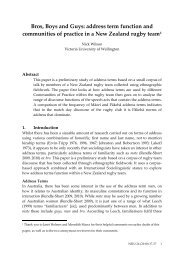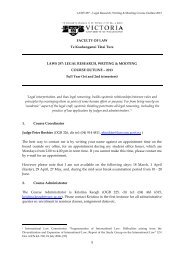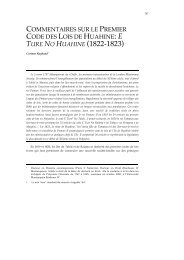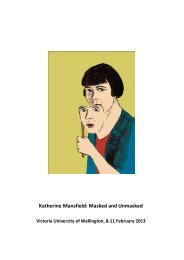The Diasporic Imaginary and the Indian Diaspora - Victoria ...
The Diasporic Imaginary and the Indian Diaspora - Victoria ...
The Diasporic Imaginary and the Indian Diaspora - Victoria ...
Create successful ePaper yourself
Turn your PDF publications into a flip-book with our unique Google optimized e-Paper software.
<strong>The</strong> <strong>Diasporic</strong> <strong>Imaginary</strong> <strong>and</strong> <strong>the</strong> <strong>Indian</strong> <strong>Diaspora</strong><br />
7 Of course, in any nation, communities that have had little difficulty in becoming part of <strong>the</strong><br />
nation’s gr<strong>and</strong> narrative through assimilation, cease to be diasporic in this sense.<br />
8 I thank David McInerney for drawing my attention to Renata Salecl’s work.<br />
9 Marcella Polain, “<strong>The</strong> Third Collision: <strong>The</strong> Armenian Genocide <strong>and</strong> After.” Paper presented<br />
to <strong>the</strong> Krishna Somers Foundation for <strong>the</strong> Study of <strong>Diaspora</strong>s, Murdoch University, 13<br />
August 2003.<br />
10 <strong>The</strong> Third Reich killed 600,000 gypsies, almost one-third of <strong>the</strong> total population of<br />
European gypsies. In Romania, Slovakia, Germany <strong>and</strong> Hungary <strong>the</strong>y still exist in <strong>the</strong> margins<br />
of mainstream cultural life. See Katie Trumpener (1992).<br />
11 Jonathan M Hess’s study considers at length <strong>the</strong> links between modernity <strong>and</strong> <strong>the</strong><br />
problematization of Jewish identity. <strong>The</strong>re were those like Abraham Geiger (1810 – 74) who<br />
read Jesus as a figure who “bequea<strong>the</strong>d to modernity” modern characteristics – such as<br />
enlightenment <strong>and</strong> critical thinking – by virtue of his engagement with Judaism. As Hess cites<br />
(2002: 91), in an unpublished note (March 1770) Moses Mendelssohn wrote: “And Jesus a<br />
Jew? – And what if, as I believe, he never wanted to give up Judaism?” Kant, of course, felt<br />
o<strong>the</strong>rwise <strong>and</strong> denied that <strong>the</strong> “pure religion of reason” (Christianity) had anything to do with<br />
Judaism. As Hess argues (2002: 208), <strong>the</strong>re was, in <strong>the</strong> end, something out of joint as<br />
modernity, in its attempt to create a universal subject, produced, from within its very<br />
principles of secular universalism, <strong>the</strong> language of anti-Semitism.<br />
12 In 1914 <strong>the</strong> population of Palestine was around 690,000, of which fewer than 60,000 were<br />
Jews.<br />
13 F. R. Leavis in his influential <strong>The</strong> Great Tradition writes about Daniel Deronda as two different<br />
books: one, <strong>the</strong> Deronda book, which is “<strong>the</strong> bad half ” (94), <strong>and</strong> <strong>the</strong> o<strong>the</strong>r, “<strong>the</strong> good part,”<br />
which he calls <strong>the</strong> Gwendolen Harleth book (100). To Leavis, George Eliot’s Zionist inspiration<br />
results in an “emotional flow” which leads to writing that is self-indulgent <strong>and</strong>, in <strong>the</strong> end,<br />
insincere. At <strong>the</strong> level of art, I think Leavis correctly suggests that <strong>the</strong> moral insight that<br />
could have come only though a forthright engagement with <strong>the</strong> Deronda-Gwendolen side of<br />
<strong>the</strong> plot gets attenuated because of <strong>the</strong> imperative of a “racial mission” (a world-historical<br />
mission, after Lukács) that must insist upon <strong>the</strong> union, via a presumed love, of Deronda <strong>and</strong><br />
Mirah, simply because <strong>the</strong> latter is a Jew <strong>and</strong> Gwendolen isn’t.<br />
14 I follow Edward W. Said, <strong>The</strong> Question of Palestine (1980). I thank my former PhD student<br />
Maria Degabriele for drawing my attention to this work some years back.<br />
15 <strong>The</strong> difference between Ashkenazi <strong>and</strong> Sephardim (or Mizrahim, “Arab Jews”) complicates<br />
a single narrative of Zionism. Fur<strong>the</strong>r, <strong>the</strong> Holocaust or Shoah, “<strong>the</strong> defining negative event<br />
of Jewish exilic existence” (Arad 2003: 5), as it gets rendered in contradictory Israeli state<br />
discourses, cautions us against constructing an unproblematic diasporic metanarrative around<br />
<strong>the</strong> Jewish experience. In Gulie Arad’s fascinating account, we read how <strong>the</strong> Shoah has shifted<br />
from conscious state-endorsed “disrememberance” (none o<strong>the</strong>r than <strong>the</strong> founding fa<strong>the</strong>r of<br />
Israel, David Ben-Gurion, felt that Holocaust victims signified, in Gulie Arad’s words, <strong>the</strong><br />
futility of “Jewish existence in exile”) to a sign of “Israel’s collective identity.” But where once<br />
“forgetting was essential to energize <strong>the</strong> task of creating a nation” (11), <strong>the</strong> new emphasis on<br />
<strong>the</strong> Shoah as “Israel’s collective consciousness … its political trope” (16), largely in <strong>the</strong> wake<br />
of <strong>the</strong> 1973 Yom Kippur War, prevents Israel from creating a “more inclusive counter-<br />
memory,” <strong>and</strong> a less “one-dimensional people” (26). <strong>The</strong> point of Arad’s persuasive argument<br />
is that diasporic memorializing (even of something as unpresentable <strong>and</strong> obscene as<br />
Auschwitz <strong>and</strong> Treblinka) “is not sufficient for healing or for <strong>the</strong> prevention of future evil”<br />
(26). This latter ethical imperative should never be lost in diaspora <strong>the</strong>ory.<br />
16 Although Safran concedes that <strong>the</strong> <strong>Indian</strong> diaspora is genuine in several respects (<strong>the</strong><br />
characteristics imputed to this diaspora are, however, oversimplified: middlemen role, long<br />
history, integrationist <strong>and</strong> particularist foci), he does not take up many of its self-evident<br />
features, such as homel<strong>and</strong> myth, insecurity, memory as trauma <strong>and</strong> so on.<br />
17 <strong>The</strong> South Asian (“<strong>Indian</strong>”) diaspora is conservatively estimated at 11million: Europe 1.5<br />
million (1.3 million in Great Britain), Africa 1.7 million (1.1 million in South Africa),<br />
Mauritius 600,000, Asia (excluding Sri Lanka) 2 million (1.2 million in Malaysia), Middle East<br />
21


